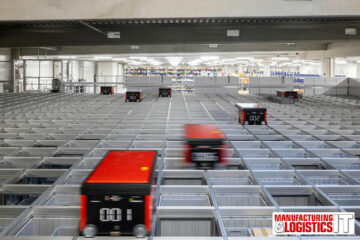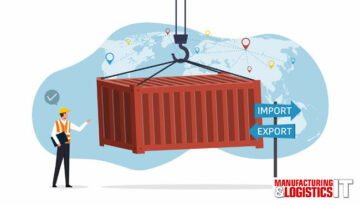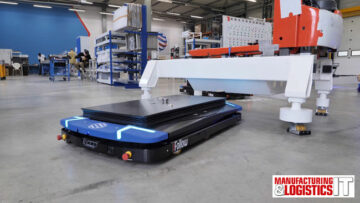By Johan Hellman, Vice President, Product & Carrier at nShift.
Ecommerce sales are tipped to hit $8.1 trillion by 2026.[1] So it’s no surprise that retailers of all sizes are keen to get hold of the biggest possible slice of the pie. Retail logistics and warehouse teams are the lynchpin of ecommerce operations.
They do more than provide the infrastructure that makes the ecommerce experience possible. What they do helps build loyalty with customers and transform the online shopping experience.
Here’re just four ways that logistics teams contribute to multichannel retail and ecommerce success:
1) Increasing conversions at checkout with more and better delivery options
One in four online shopping baskets are abandoned at checkout.[2] Some studies suggest that the figure could be closer to 50%.[3]
The lack of delivery options is one of the biggest reasons that people click away from their baskets. And offering a range of delivery options can increase conversions by 20%. The right range of options is likely to include express delivery, click and collect and lower-emissions and lower-cost alternatives.
Offering this range means having the transport capability to fulfil them through access to a range of carrier services. The warehouse must be able to print transport labels and documents for a range of carriers and seamlessly automate a range of booking processes.
nShift offers more than 1,000 carriers and 450 other integrations with business, warehouse management and other systems, right out of the box.

2) “Greening” deliveries with sustainable options and emissions tracking
A staggering 88% of consumers claim to be more loyal to a company that gives back to the world around them.[4] So it’s hardly surprising that retailers are keen to exhibit their sustainable commitments.
Businesses can provide lower-emissions delivery options to shoppers, when they have easy access to the right set of carriers. And by making sure these are clearly badged at checkout, consumers can quickly find what they are looking for, giving the retailer credit for providing it.
Logistics teams can also take the lead in measuring carbon emissions across the supply chain. Armed with real information about the current state of play, retailers can introduce strategies to reduce emissions.
This will become a critical part of everyday business when in mid-2024 the Corporate Social Responsibility Directive makes it obligatory for 50,000 companies doing business in the EU to measure and report on their greenhouse gas emission.
By continuing to measure emissions, the retailer can check if their strategies are making progress and demonstrate improvement to customers.

3) Take ownership of customer communication
If you think logistics has little to do with customer service, think again. In fact, there are huge benefits to regularly communicating with customers during the delivery process. Getting customer communications right can cut WISMO (“where is my order”?) calls by 60%.
But leaving these communications to the carrier company is a missed opportunity. By taking control of delivery updates, retailers can brand the messages in their own look and feel.
Shoppers are far more likely to open communications about an expected delivery than they are other messages from retailers, and that gives omnichannel retailers the opportunity to suggest other things that customers might like to buy.
Logistics teams can make this enhanced customer experience possible by introducing the right order-tracking software. Order tracking based on regular scanning of the delivery labels can create updates about the whole of the delivery process, not just the last mile.
nShift’s tracking software also enables retailers to communicate with their customers about what else they might want to buy, right at the time when they are paying attention.

4) Protecting profit by converting returns to exchanges
A digital returns process makes it easier to check items back in and list them for resale. With the right software and process, teams can complete a return in about five to ten seconds.
But digital returns are not just about operational efficiency. A consumer-friendly interface makes it easier to offer people exchange options, which can mean retailers don’t lose their revenue on returned items.
nShift provides a consumer-friendly returns interface which makes it easy for customers to arrange exchanges when returning goods, and so typically 30% of returns convert to exchanges.
Ecommerce and multichannel retail operations are complex, multi-faceted businesses. But by anticipating the needs of the business and focusing on customer requirements, logistics teams and warehouses can play a crucial role in growing revenue, building loyalty with customers, and ensuring that the business thrives.
[1] https://www.businessgo.hsbc.com/en/article/global-ecommerce-top-trends-in-2023
[3] https://www.linkedin.com/pulse/half-online-shoppers-abandon-carts-delivery-related-reasons-perini/
- SEO Powered Content & PR Distribution. Get Amplified Today.
- PlatoData.Network Vertical Generative Ai. Empower Yourself. Access Here.
- PlatoAiStream. Web3 Intelligence. Knowledge Amplified. Access Here.
- PlatoESG. Carbon, CleanTech, Energy, Environment, Solar, Waste Management. Access Here.
- PlatoHealth. Biotech and Clinical Trials Intelligence. Access Here.
- Source: https://www.logisticsit.com/articles/2023/11/06/retail-logistics-teams-deliver-ecommerce-success-heres-how
- :has
- :is
- :not
- 000
- 1
- 2026
- 50
- a
- Able
- About
- access
- across
- again
- All
- also
- alternatives
- an
- and
- anticipating
- ARE
- armed
- around
- article
- At
- attention
- automate
- away
- back
- based
- BE
- become
- benefits
- Better
- Biggest
- booking
- Box
- brand
- build
- Building
- business
- businesses
- but
- buy
- by
- Calls
- CAN
- capability
- carbon
- carbon emissions
- carriers
- chain
- check
- Checkout
- claim
- clearly
- click
- closer
- collect
- commitments
- communicate
- communicating
- Communications
- Companies
- company
- complete
- complex
- Consumers
- continuing
- contribute
- control
- conversions
- convert
- converting
- Corporate
- Corporate Social Responsibility
- could
- create
- credit
- critical
- crucial
- Current
- Current state
- customer
- customer experience
- Customer Service
- Customers
- Cut
- deliver
- Deliveries
- delivery
- demonstrate
- digital
- do
- documents
- doing
- Dont
- during
- easier
- easy
- ecommerce
- efficiency
- else
- emission
- Emissions
- enables
- enhanced
- ensuring
- Ether (ETH)
- EU
- everyday
- exchange
- Exchanges
- exhibit
- expected
- experience
- express
- fact
- far
- feel
- Figure
- Find
- five
- focusing
- For
- Forbes
- four
- from
- GAS
- get
- getting
- gives
- Giving
- goods
- greenhouse gas
- Growing
- Have
- having
- help
- helps
- here
- Hit
- hold
- How
- HSBC
- HTTPS
- huge
- if
- improvement
- in
- include
- Increase
- increasing
- information
- Infrastructure
- integrations
- Interface
- introduce
- introducing
- IT
- items
- jpg
- just
- Keen
- Labels
- Lack
- Last
- last mile
- lead
- leaving
- like
- likely
- List
- little
- logistics
- Look
- looking
- lose
- loyal
- Loyalty
- make
- MAKES
- Making
- management
- mean
- means
- measure
- measuring
- messages
- might
- missed
- more
- multichannel
- must
- my
- needs
- no
- of
- offer
- offering
- Offers
- omnichannel
- on
- ONE
- online
- online shopping
- open
- operational
- Operations
- Opportunity
- Options
- order
- Other
- out
- own
- ownership
- part
- paying
- People
- plato
- Plato Data Intelligence
- PlatoData
- Play
- possible
- president
- process
- processes
- Product
- Profit
- Progress
- protecting
- provide
- provides
- providing
- quickly
- range
- real
- reasons
- reduce
- regular
- regularly
- report
- Requirements
- responsibility
- retail
- retailer
- retailers
- return
- returning
- returns
- revenue
- right
- Role
- s
- sales
- scanning
- seamlessly
- seconds
- service
- Services
- set
- Shoppers
- Shopping
- sizes
- Slice
- So
- Social
- Software
- some
- staggering
- State
- strategies
- studies
- success
- suggest
- supply
- supply chain
- sure
- surprise
- surprising
- sustainable
- Systems
- Take
- taking
- teams
- ten
- than
- that
- The
- the world
- their
- Them
- There.
- These
- they
- things
- Think
- this
- thrives
- Through
- time
- to
- Tracking
- Transform
- transport
- Trillion
- typically
- Updates
- vice
- Vice President
- want
- Warehouse
- warehouse management
- ways
- What
- when
- which
- whole
- will
- with
- world
- you
- zephyrnet












